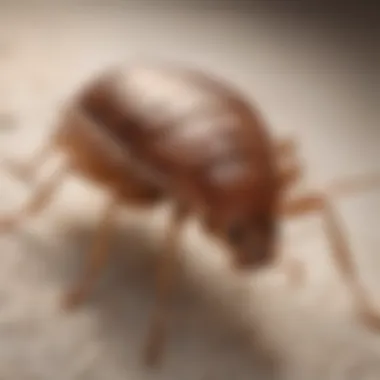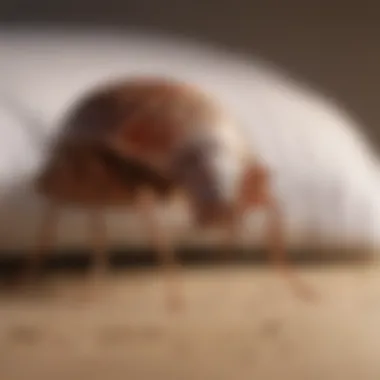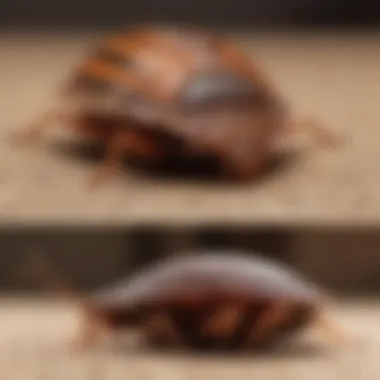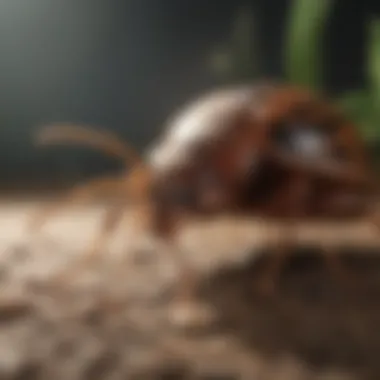Understanding the Smell of Bed Bugs: What You Need to Know


Intro
The subject of bed bugs and their distinct odors is not just about nuisance. It is crucial for understanding their behavior and, importantly, for effective pest control. Bed bugs are small, biting insects that have plagued human habitations for centuries. Beyond discomfort, they can lead to sleepless nights and increased anxiety. Therefore, comprehending the scents they produce offers valuable insights into identifying infestations and developing eradication strategies. This article will explore the specific odors associated with bed bugs, what they indicate, and how they aid in detection.
Animal Overview
Common Name and Scientific Classification
Bed bugs belong to the family Cimicidae, with the most common species being Cimex lectularius. They are often referred to simply as “bed bugs” due to their preference for living in close proximity to human sleeping areas.
Physical Characteristics
Adult bed bugs are approximately 4 to 5 mm in length and have a flattened, oval-shaped body. Their coloration varies from light brown to reddish-brown, depending on whether they have recently fed. Juvenile bed bugs, called nymphs, are smaller and more translucent, making them less noticeable.
Habitat and Distribution
Bed bugs are found globally, thriving in homes, hotels, and public transportation. They tend to hide in cracks, crevices, and upholstered furniture, making them highly adaptable. Their dispersal is often linked to human movement, as they latch onto luggage and clothing.
Understanding Bed Bug Odors
Bed bugs emit a variety of smells that can vary depending on their life stage, health, and interaction with other bed bugs. Recognizing these odors can be critical for detection and monitoring.
Types of Odors Emitted
- Almond-like scent: This is often associated with large infestations. It is thought to come from the scent glands of bed bugs.
- Musty odor: A more common scent that may indicate smaller populations.
Causes of Odors
The odors are produced by the bed bugs' excretions and scent glands. This characteristic is not only a means of communication among their kind but can also serve as a warning signal to other bugs about danger in their vicinity.
It is crucial that households familiarize themselves with these scents to enable timely detection and action.
Implications for Detection and Eradication
Awareness of bed bug odors is immensely helpful for both professionals and individuals facing infestations. The scents can guide inspections, often leading to early detection before populations explode. Avoiding common pitfalls, such as overlooking these odors, can significantly ease the process of eradication.
Practical Advice for Households
- Regularly check for odors in typical bed bug hiding spots, such as under beds and in cracks.
- Consider professional assistance if strong odors are detected, as this often indicates a significant problem.
Understanding the importance of bed bug odors ultimately contributes to a proactive approach in managing these pests. By recognizing their smells and acting upon them, individuals can mitigate infestations and restore comfort to their homes.
Overview of Bed Bugs


When discussing bed bugs, it is important to understand their biological makeup and behavior. Bed bugs, known scientifically as Cimex lectularius, are small insects that feed on human blood. This aspect of their biology makes them a significant concern for households and professionals alike. Their presence can lead to both discomfort and anxiety.
Biology of Bed Bugs
Bed bugs are typically oval and flat, allowing them to hide in tiny crevices. Adults measure about 5 to 7 millimeters in length and have a reddish-brown color. Their mouthparts are adapted for piercing skin and sucking blood, a process that occurs primarily at night. Understanding their life cycle is crucial; bed bugs undergo five nymphal stages before reaching adulthood, with each stage requiring a blood meal to proceed to the next.
Their ability to survive without food for months adds to their resilience. This trait complicates eradication efforts, making it essential for those dealing with infestations to be aware of their biology.
Habitat and Behavior
Bed bugs prefer dark and secluded environments. Common hiding spots include mattress seams, box springs, bed frames, and even baseboards. Their nocturnal nature makes them difficult to detect. They often emerge at night to feed, making their presence largely unnoticeable until an infestation is already underway.
The social behavior of bed bugs also plays a role in their proliferation. They tend to gather in groups, which further escalates the problem when they infest a living space. Understanding these behavioral patterns allows for more effective detection and intervention strategies.
Understanding the biology and behavior of bed bugs is crucial for effective management and control strategies. Knowing where they hide and how they reproduce can greatly influence eradication success.
In summary, comprehending the biology and habitat preferences of bed bugs equips individuals and pest control professionals with the knowledge necessary for effective prevention and control. Knowledge about these insects is the first step in managing their presence and impacts.
Identifying Bed Bug Infestation
Bed bug infestations can be difficult to spot in their early stages. Recognizing the signs of infestation is crucial for effective control and prevention. Understanding common indicators not only saves time but also reduces the emotional toll associated with these unwanted pests. This section will delve into vital signs of bed bug presence and the significant role smell plays in detection.
Common Signs of Infestation
Detecting bed bugs early can prevent severe infestations and reduce the cost of extermination. Common indicators include:
- Bites: Small, itchy welts on skin, often in clusters or lines.
- Fecal Droppings: Tiny dark spots on mattresses, furniture, or walls.
- Shed Skins: Bed bugs molt as they grow, leaving behind translucent skins.
- Blood Stains: Small reddish stains on bedding or mattresses.
- Live Bugs: Adult bed bugs are about a quarter-inch long, brownish, and visible to the naked eye.
These signs are not just nuisances but alerts that require immediate attention. Ignoring them can transform a minor issue into a significant infestation, leading to costly solutions and prolonged discomfort.
Role of Smell in Detection
The smell emitted by bed bugs is another critical cue in identifying their presence. They produce a unique odor, often described as musty or reminiscent of a damp cloth. The scent comes from their scent glands and can intensify when they feel threatened or are in larger numbers.
Using scent as a detection method has some advantages:
- Early Warning: A noticeable odor can indicate a larger infestation even before visible signs appear.
- Informed Treatment: Understanding odor patterns can help focus eradication efforts more effectively.
- Continuity of Monitoring: Regularly checking for smells can help in monitoring ongoing issues.
Research indicates that trained dogs can detect bed bugs through their sense of smell, showcasing the importance of this aspect in pest control.
By paying attention to both visible signs and odors, homeowners can implement strategies that are timely and effective. This holistic approach can significantly enhance control measures against bed bugs.
Do Bed Bugs Emit Smells?
Bed bugs, though small and elusive, communicate and react through various means. Among their many traits, the ability to emit smells plays a crucial role in their behavior and home invasion strategies. This aspect is important for understanding how to detect and manage bed bug infestations effectively. By recognizing the types of smells that bed bugs produce, individuals can more easily identify the presence of these pests before they become a larger issue.
Types of Smells Associated with Bed Bugs
Bed bugs release distinct odors that can signal a presence or an infestation. The specific smells include:


- Sweet or Musty Odors: Often described as sweet, the scent resembles that of overripe berries. This odor is produced by bed bugs when they are disturbed or during mating.
- Sour Smells: A sour, sometimes similar to mold, is noted especially in cases of larger infestations. This smell can be indicative of a significant number of bed bugs clustered in confined areas.
- Chemical or Pungent Odors: This occurs primarily when bed bugs are crushed. The scent is generally unpleasant and can alert individuals of a possible infestation when present in significant amounts.
Understanding these smells can help in identifying and addressing bed bug problems early on. The presence of these odors can prompt homeowners or pest control professionals to take action more quickly, thereby minimizing the impact of an infestation.
Chemical Composition of Bed Bug Odor
The odors emitted by bed bugs are not just random scents but are largely influenced by their biology. The chemical composition consists of various compounds. These compounds include:
- Alkanes and Aldehydes: These are organic compounds that contribute to the sweet or fruity aromas.
- Acids: Short-chain fatty acids are responsible for the sour notes in bed bug odors.
- Ketones: These contribute to the pungent smells noticeable when bed bugs are crushed.
The unique combination of these chemicals means that bed bug odors can act as signals to other bed bugs. They communicate information like distress or territory. Understanding this aspect is crucial for detection and effective pest control. It can guide pest control strategies, leading to better outcomes for infested households. Knowing what to look for can be immensely beneficial for anyone dealing with these pests.
The smells emitted by bed bugs serve multiple purposes. They can communicate vital information about their environment, helping both bed bugs and humans recognize the presence of an infestation.
Factors Affecting Bed Bug Odor
Understanding the factors that influence bed bug odor is critical for effective identification and control of infestations. Various elements can impact the type and intensity of smells emitted by these pests. Knowledge in this area helps homeowners, pest control specialists, and researchers devise strategies for detection and eradication. This section explores two primary aspects: the life stage of bed bugs and their responses to threats.
Life Stage of Bed Bugs
The life stage of bed bugs plays a significant role in the odors they release. Bed bugs undergo several developmental stages: egg, nymph, and adult. Each stage has different physiological characteristics that can affect their scent production. For instance, young nymphs might emit less intense odors compared to adult bed bugs. The presence of pheromones is stronger in adults, especially when they are mating or disturbed.
Factors such as nutrition and environmental conditions can also play a part in the scent profile. Well-fed bed bugs may produce different smells compared to starved ones. Research suggests that starved bed bugs can be more aggressive in their odor production, possibly as a means of attracting mates or seeking out food.
Response to Threats
Bed bugs have an instinctive response to threats that directly influences their scent emissions. When disturbed or threatened, bed bugs release alarm pheromones. These signals can have varying effects on their fellow bed bugs. For instance, they can trigger a heightened state of awareness, leading to increased movement and scattering. This response is a survival mechanism that allows them to evade potential dangers, but it also impacts their detected odors.
This release of alarm pheromones can create a specific scent that serves as a warning to other bed bugs in the vicinity. It is essential for pest control professionals to understand this behavior, as it aids in identification and can inform treatment methods. The capacity to recognize these odors and their implications allows for a more precise approach to managing bed bug infestations.
"Understanding how various factors can influence bed bug odors offers vital insights for effective pest management."
Comparison of Bed Bug Odors with Other Pests
Understanding the comparison of bed bug odors with other pests is essential for effective pest management. Different pests have distinct smells which can serve as helpful indicators of their presence. Recognizing these odors fosters a more informed approach to pest control, guiding homeowners and professionals alike in their efforts to identify and eradicate these nuisances. Within this framework, knowing how bed bug odors contrast with those of fleas and cockroaches reveals significant insights into effective detection methods and eradication strategies.
Bed Bugs vs.
Fleas
Fleas and bed bugs may occupy similar environments, but their odors are remarkably distinct. Flea infestations often emit a musky odor, described as earthy and almost reminiscent of dampness. This smell arises mainly from the feces and bodily fluids of fleas, particularly when they are in large numbers.
On the other hand, bed bugs produce a slightly different scent. Many people describe it as a sweet yet musty odor, similar to the smell of overripe fruit. This odor primarily comes from the aggregation pheromones released by bed bugs, which they utilize for communication. It is important to note:
- Flea odors can be more pronounced in pet areas.
- Bed bug odors may be more evident in sleeping areas, such as bedding and mattresses.


The ability to differentiate between these two types of odors is crucial for accurate identification. Misidentifying a smell could lead to ineffective treatments, as each pest requires a tailored approach for control and elimination.
Bed Bugs vs.
Cockroaches
When considering cockroaches, the situation becomes complex as their odor is often associated with a strong, oily scent that some describe as similar to spoiled food. Cockroaches secrete various chemicals, resulting in an odor that can pervade living environments. Their presence often indicates unsanitary conditions that can attract other pests, including bed bugs.
In contrast, the specific odor of bed bugs remains distinct enough to help homeowners and pest control professionals in their detection efforts. Some key differences include:
- Cockroach Odor: Oily, strong, reminiscent of rotten food.
- Bed Bug Odor: Sweet, musty, likened to overripe fruit or damp cloth.
Understanding these odors not only enables better detection but also sheds light on the environmental conditions conducive to each pest's presence. It is important, as addressing one pest may inadvertently affect another if pest management practices are not correctly executed.
Effective pest management relies heavily on recognizing the differences in odor. Misunderstanding these odors can lead to wasted resources and persistent infestations.
In summary, the comparison of bed bug odors with those of fleas and cockroaches highlights the importance of proper identification in pest control. By accurately distinguishing these scents, professionals can implement more effective eradication strategies, ultimately leading to healthier living environments.
Practical Implications of Bed Bug Odors
Understanding the odors associated with bed bugs goes beyond mere curiosity. It holds critical practical implications for those dealing with infestations. This section emphasizes how recognizing specific scents can play a significant role in detection and control strategies. The ability to identify these smells also informs preventative measures that can be implemented in homes and businesses.
Using Smells for Bed Bug Control
The distinct odors emitted by bed bugs can serve as valuable indicators during infestation monitoring. Pest control professionals often utilize scent cues when devising eradication techniques. For instance, if a particular odor is detected, it may guide the technician to inspect certain areas more closely.
In addition to aiding professionals, homeowners can become more awareness of these scents, improving their detection capability. Simple things like regular checks for unusual smells can inform individuals about early signs of a problem. Effective control can thus stem not only from chemical treatments but also from understanding and harnessing the natural odors bed bugs emit. This nuanced approach can enhance efficacy and lead to quicker resolutions.
Psychological Effects of Odors on Infestation
The presence of certain odors can impact the way individuals perceive infestations. Studies show that foul smells associated with bed bugs may evoke anxiety or distress among those experiencing infestations. The psychological implications are as significant as the physical effects of the pests themselves.
Furthermore, strong odors may cause residents to react more quickly, prompting faster action against the infestation. This immediate response can mitigate the spread and severity of an invasion.
“Understanding the psychological effects of bed bug odors offers insight into human behavior in the presence of pests. Such knowledge is crucial for pest control professionals”.
Closure
The discussion around the odors emitted by bed bugs is not simply academic; it has very real implications for pest management. There are several key elements to consider in understanding this topic. Firstly, recognizing the specific smells produced by bed bugs can significantly enhance detection capabilities. The ability to identify these scents may allow households and professionals to address infestations more quickly and effectively.
Summary of Key Findings
Throughout the article, several important findings have emerged regarding the odors of bed bugs. Notably, these insects release pheromones that can signal various states, such as alarm or mating. The most notable odor associated with bed bugs is often compared to the scent of rotten raspberries or coriander, which can be quite distinct and alarming for those infested. Moreover, the type of smell can change depending on the bed bug's life cycle. Younger bed bugs emit different scents compared to mature ones. This understanding pinpoints the necessity of being aware of odor variations that signify varying levels of infestations.
Recommendations for Homeowners and Professionals
For homeowners and pest control professionals, recognition and interpretation of bed bug odors can serve as a proactive measure against infestations. Consider the following recommendations:
- Regular Inspections: Utilize smell as an additional diagnostic tool during regular home inspections. Catching a scent can be an early indicator of an infestation before physical signs manifest.
- Educate Yourself: Familiarize yourself and your family with the various smells associated with bed bugs. The more you know, the better you can respond.
- Professional Consultation: In cases of significant odors, consider engaging professional pest control services. A trained expert can utilize advanced detection methods alongside odor recognition for more efficient eradication strategies.
By applying these insights, individuals can create a proactive approach in managing bed bug concerns, ultimately leading to healthier living environments.







